|
|
 |
Weather observations during summer time - The test of the Seven Sleepers’ rule
You should have had a look at worksheet one, in which you can interactively predict your summer.
Then you should have your weather sheet ready. (download worksheet)
Select a city in Central Europe and fill the table.
Also, did you know that there is a European Weather chain, also for schools?
 http://www.meteo-webring.de/ http://www.meteo-webring.de/
|
|
Date |
max temperature (°C) |
rainfall (mm) |
within prediction |
|
27th of June |
|
|
|
|
28th of June |
|
|
|
|
29th of June |
|
|
|
|
30th of June |
|
|
|
|
1st of July |
|
|
| |
|
|
|
|
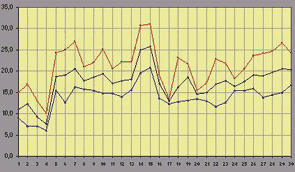 |
 |
June 2001, in red: max temp, in black: day average, in blue: min temp |
|
 |
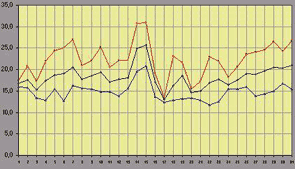 |
 |
July 2001, in red: max temp., in black: day average, in blue: min temp. |
|
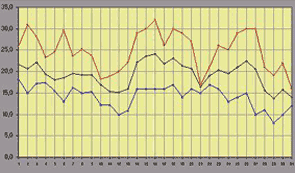 |
 |
|
August 2001, in red: max temp., in black: day average, in blue: min temp.
Weather facts of 2001, author: HS Gmuend, Dieter Schuh, image source: http://www.hsgmuend2.ac.at/wetterseiten/index.htm
|
|
 |
|
Now you can test our Seven Sleeper’ Rule according to temperature prediction.
If you click on the left button, you will see the number of days and
if you click the right button you will see the probability in percentage.
|
First accept as a definition of a “summer day” the maximum temperature of 25 oC or more.
In how many days did this occur during the 57 days (June 27 plus 7 weeks, i.e. until August 22)
|
 |
|
If we change the definition of a summer day into 20 oC and above, in how many days did this occur?
|
 |
|
|
But we can also add another definition considering the rainfall.
The minimum definition of a “good summer” day could be the absence of rain.
|
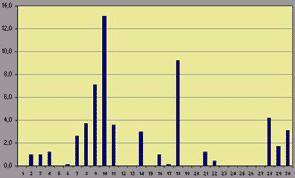 |
 |
rainfall in June 2001
author: HS Gmuend, Dieter Schuh, image source: http://www.hsgmuend2.ac.at/wetterseiten/index.htm |
|
 |
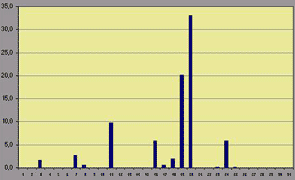 |
 |
rainfall in July 2001
author: HS Gmuend, Dieter Schuh, image source: http://www.hsgmuend2.ac.at/wetterseiten/index.htm |
|
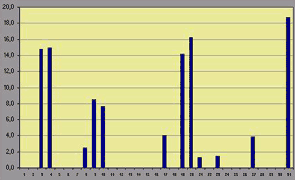 |
 |
|
rainfall in August 2001
author: HS Gmuend, Dieter Schuh, image source: http://www.hsgmuend2.ac.at/wetterseiten/index.htm
|
|
 |
|
|
Now you can test our Seven Sleeper’ Rule according to the number of days with rainfall.
If you click on the left button, you will see the number of days and if you click the right button you will see the probability in percentage.
|
How many days had no rainfall?
|
 |
|
How many days had negligable rainfall, i.e. less than 10 mm?
|
 |
|
|
Now a combination of the definitions:
A good summer has daily maximum temperatures over 20 C and little rain (below 10 mm).
This includes small thunderstorms which are also typical when high temperatures occur.
Another year was 2003 when the Rule was perfectly right.
And how did it affect you in your home region in 2001 and 2003?
What is now your opinion on the Seven Sleepers’ Rule?
And you certainly know why we assume only a 75% probability for the Rule and not 77% or even 89% as in our case.
Further discussion
1. We have chosen the daily maximum temperature to define “summer”. What else could you select?
2. What other weather rules do you know?
3. Why is a hot summer rather fun for the city dwellers and not for the farmers?
4. Modern weather predictions are so different. Use the LINKS and find out how.
|
About this page:
- Author: Dr. Schrettenbrunner - University of Nürnberg - Germany
- scientific reviewing:
- educational reviewing: Dr. Yvonne Schleicher, Julia Heres
- last update: 27.08.03
|
|
 |
|









